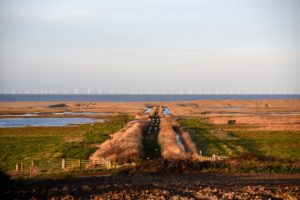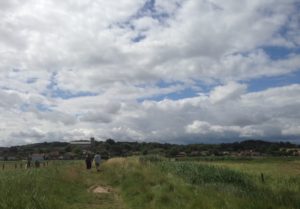Every year, we give over all of December (and usually most of January) to a series called ‘Shadows and Reflections’, in which our contributors share highs, lows and oddments from the past 12 months. Today it’s the turn of Katherine Price.
Turbines, nightjars and forty per cent of the time

View of the shingle bank along Mill Drift. Photo: Merlin Turville-Petre
One night, nearly fifteen years ago, when G had become really sick, I was sitting by her bed upstairs in the cottage at Salthouse. She had already retreated into a sensory world, and she was stroking a stone with her thumbs and staring unseeing at something brilliant and noisy on the telly to do with the Olympics.
The cottage is on the coast road, and on that moonlit night I could see straight out across the saltmarsh to the shingle bank that has been there — in some form or other — since it was thrown up by the last retreating glacier. The shingle bank meant that from the cottage you couldn’t see the sea.
While G loved this coast, for some people it was too quiet. Land meeting sea meeting sky with a murmur, not a bang. ‘Sounds easy, looks simple, only consisting/of stones, water and air – three horizontal/bands of pale element, and just the gentle/wash of the North Sea in the English morning’ (from ‘Salthouse Beach’, a poem by Sebastian Eden).
Now though, looking north, the view is interrupted. G didn’t stick around to see the Sheringham Shoal Offshore Wind Farm, eleven miles out to sea. I wonder what she’d have thought of it. Eighty-eight wind turbines that play tricks with your mind. Under brooding cloud, a menacing Wellsian army; on a clear sunny day, pin-sharp and jaunty, just another of the anodyne beach hut-wind break-sailboat complex of holiday home screen prints; on a misty evening, vague and dreamy, beautiful even; at night, a horizontal band of red lights, blinking a code that I can’t fathom.
The Sheringham Shoal website says that ‘the turbines are visible from the shore approximately 60% of the time, depending on the weather.’ I can’t fathom this either. Is that sixty percent of daylight hours? Sixty percent of twenty-four hours? Is that averaged out over a week, a month, a year? As the seas rise due to climate heating will we see the wind farm more or less? As the weather gets wilder, will we see more clearly more often? Maybe. Metaphorically, at least.
One day in May this year I was on the shingle bank again. Fishermen had pitched small tents at regular intervals along the beach, their bright colours smeared pastel by the sea spray. I was remembering G, soothed by the stone, sea, sky combo and the rhythm of the waves. It was forty per cent time, the turbines obscured by haze, so I didn’t have to deal with the visceral reaction the windfarm always gives me. Didn’t have to think about what it means, whether it’s good or bad, whether I’m doing enough or not doing enough, whether technology can keep the sea at bay, whether — as a grandmother now and aware of the human catastrophe ahead — I even dare imagine that the floods might serve the planet well, just like in the Noah legend, kick us all out, now and forever, amen.
We wandered back under the big sky along the old track, reed-filled ditches either side of us trickling with warblers’ song, waders in the salt lagoons, bubbling calls of oystercatchers, the shadow of the marsh harrier on the hunt. The old village sprawled ahead along the coast road, Salthouse Heath up on the ridge, St Nicholas’ church on the hill between them.

View of Salthouse from the grazing marsh. Photo: Katherine Price
St Nicholas’ is late perpendicular, built by 15th century merchant wealth when Salthouse was part of a great port, reached by a creek that led from the harbour at Blakeney. The creek silted up and the trade went and the people with it, but the church remains, austere, serene, full of natural light. That evening there was a concert, three of Bach’s six cello suites, the music spinning order out of chaos, a refuge from apocalyptic thoughts. The cellist was still playing when the sun set at two minutes to nine, just as it was supposed to, and from the dim nave the huge east window was still bright and we watched the shadow play of swifts, rushing and screaming against the sky.
After the concert we went at a good clip up to the heath, trying to outrun the dusk that would fall at twenty to ten. I was thinking about the swifts, thinking whatever heights human creativity can reach — the church, the score, the performance — the natural world effortlessly reaches higher. There’s beauty and then there’s the sublime. We got both.
Salthouse Heath is a mosaic of acid grassland and dry heath, with scrub of gorse and sycamore, bounded by blackthorn. It has meant a lot for a long time — more than forty Bronze Age burial mounds are scattered across it. The air was warm and still, and there were other people up there, talking in hushed tones, stopping and listening in the silky twilight, waiting for the nightjars.
The birds return annually to breed before leaving for their wintering grounds in southern Africa. They’re here from late April until August, forty per cent of the year. The low electric churring of the males started in one place and then another and another, their song shifting from light to dark and back again, each individual with a unique pulsing pattern that can carry for half a mile. There’s no sound like it, not crickets, not frogs, and it drills into you, insistent, disorientating, transporting. God, I was on tiptoes I was so excited. We started to see them on the wing, their flight calls — blunt whistles — helping us locate them between the trees as they hunted for insects, their hawk-like silhouettes tracing arcs against the soft sky in another thrilling shadow-play. And sometimes there was the strange territorial clapping of wings, like paper bags being snapped open.
Eventually we let go, bouncing along the ridge, exhilarated by what we’d shared, and turned towards the village and the sea. Nine thousand years ago you’d have had to travel many miles further to get to the shoreline, which was more than fifty metres lower than it is now. You’d have made your way over steppe, expansive grassland with a scattering of trees, cut through by lakes and rivers. Rich hunting grounds. By six thousand years ago, swollen by the melting glaciers, the sea had drowned Doggerland.
And it keeps on coming. The shingle bank is advancing towards the village by three quarters of a metre each year and the sea-level will rise by as much as half a metre by 2050. Fifteen years ago, the government had already changed policy, transitioning from the Knut-like fight against the tide to ‘supporting communities on the coastline to adapt to and manage the risks of climate change’, as Defra delicately puts it.
As we skipped down the hill, a line of red lights blinked along the horizon. Sixty per cent of the time, you have to bottle up your joy and face facts.
When I was sitting there with G in her bedroom, staring out over the saltmarsh, a sudden movement caught my eye. The flood warden had been along earlier, but it still took a while to make sense of what I was seeing. Caught in the act by the moonlight, the sea coming quietly, purposefully over the shingle bank.
In hopeful moments, I can imagine a good future. The grazed marsh reverting to a teeming tidal saltmarsh, more carbon sequestered, a greater buffer zone against the flood, the nightjars and nightingales returning in hordes, spilling out beyond the heath down towards the village.
Forty per cent of the time, you’ll find me chasing beauty and wildness and glimpses of the sublime.
*
Seb Eden’s poem is published in ‘Salthouse: The Story of a Norfolk Village’, FN Stagg, Val Fiddian.
For Steve Harris’s fascinating account of Salthouse, visit www.salthousehistory.co.uk
Orlando Jopling’s cello pilgrimage www.cellopilgrimage.blogspot.com